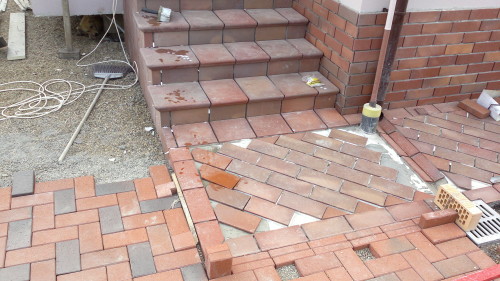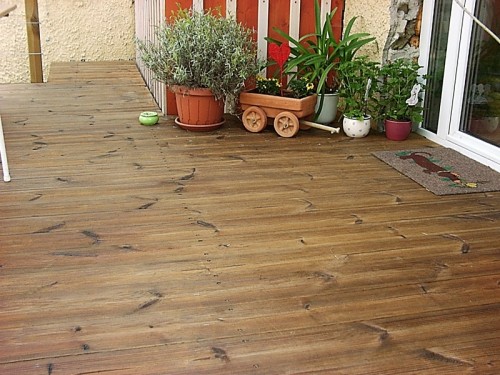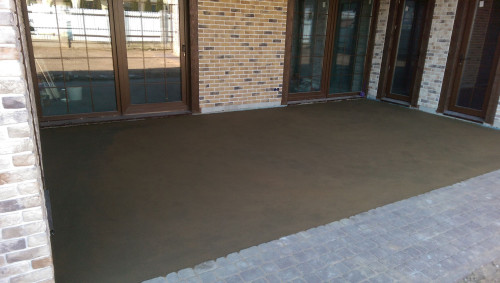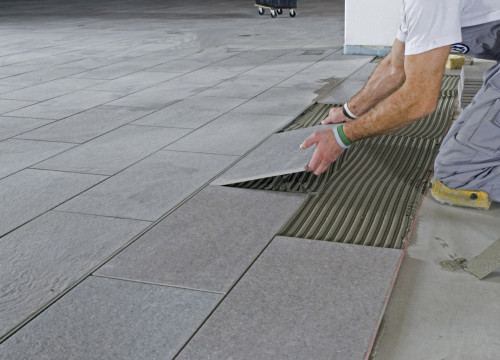The terrace is a place that connects a country house with a landscape. Properly selected floor covering of this architectural element will make an attractive transition from the building to the environment. The most optimal option will be the floor tile for the terrace.
Content
Requirements for coating
When acquiring a material, attention is paid to two main characteristics, thanks to which the coating will serve as a maximum period of outdoor conditions. These include frost resistance and durability.
The frost resistance rate is directly proportional to the moisture absorption of the material. Minimal moisture absorption indicates the best frost resistance. The level of moisture absorption tiles for the open terrace should not exceed 3%.
Strength must match the level of 5-6 on the Moos scale. Only such an outdoor coating will be resistant to rapid abrasion.
It should also be noted that it is recommended to acquire a tile that has anti-slip qualities. On the packaging to the products, this characteristic is indicated by the letter R. The greater the number near the letter, the better the anti-slip quality of the flooring (for example, a tile with marking R13 is safer than material with R12 marking).
Requirements are imposed on the installation of frost-resistant tiles for the terrace. The main ones are:
- the use of special glue, which has maximum elasticity;
- the presence of a minimum slope from the wall in the amount of 12º;
- lack of emptiness under the coating;
- creation of intercepting seams with an optimal width (more than 3 mm);
- close up of compensation seams (if any) sealant of polyurethane.
Terrace coating materials
Different materials can act as a floor covering of the terraces:
- ceramic tile;
- terracotta;
- clinker;
- porcelain stoneware;
- marble;
- copingian stone;
- a natural stone;
- wooden tile.
The advantages of using ceramic tiles for the terrace - ease of care and an attractive appearance. The "minus" of the material is the rapid heating of the surface on hot days.
The terracotta is a glazed and painted clay tile. It is a frost-resistant and durable product. For the terrace, the material is suitable, which has a rough surface and a frosted glaze.
The clinker tile for the terrace has a low moisture absorption indicator (reaches only up to 0.7%). Due to this, the material is frosty. In addition, the clinker is characterized by resistance to high temperature and increased wear resistance.
Porcelain stoneware is a solid and rough material. Resistant to pollution, chemical medium and premature abrasion.
Marble is suitable for facing the floor of only covered terraces. This is due to the fact that this material is too susceptible to the negative effects of atmospheric precipitation. Marble will need to soak the special composition.
The coping stone includes granite crumb and fine-grained concrete. Due to this, the facing material has an attractive appearance and a non-slip surface. COING is practically immune to temperature fluctuations and moisture drops.
The use of natural stone contributes to a organic compound with the environment. Among the variety of types of stone for finishing the terraces is better suited for basalt or granite tiles.
The wooden tile for the terrace of thermoderev in the manufacture is exposed to high temperatures. Such material does not need to additionally process the antiseptic. It is resistant to the influence of fungi, wet environments and temperature drops.
The most suitable options for the terraces are porcelain and clinker. It does not fit the floor covering with polished and slippery surface. Yes, and a mosaic for which the creation of a large number of seams is characteristic is an unacceptable solution.
Preparatory stage
It consists of:
- pouring a concrete screed;
- purification and priming surface;
- preparation of adhesive composition.
Concrete screed
At the initial stage, surface preparation should be done. Tile laying technology on the terrace involves the presence concrete screed. Installation of flooring can be carried out on the old floor (if it is in good condition and its clutch with the surface does not cause complaints). But in this case it is worth considering that the level of gender will increase significantly.
The device of the screed is carried out using only high-strength M500 concrete, which is stirred with sand in a 1: 2 ratio. After that, plasticizers are added to the concrete solution, thanks to which the speed and setting level of concrete occurs.
Cleaning and priming surface
After the final pouring of the concrete screed (it will take about 30-40 days) the surface is cleared of dust and garbage. To do this, use a brush with a thick pile.
The concrete surface is grounded with a special frost-resistant mixture. Its manufacture is as follows:
- the primer is diluted with water in proportion 1 to 3;
- a small amount of glue is added to the solution intended for mounting tiles;
- the resulting composition should be dark sand color and without problems applied to the surface (not too liquid and not too thick).
In the process of applying, the composition is subjected to constant stirring. This is due to the fact that the glue is heavier than the primer mixture (it settles on the bottom of the tank). To cover the surface with a uniform layer of primer, a brush with a thick and thick pile is used. Paul dries during the day.
Preparation of tile glue
This process consists of two main actions:
- in a plastic bucket filled with water, dry glue is poured;
- the mixture is thoroughly mixed with a construction mixer.
Dry glue is diluted with water until a mixture is disabled without lumps, which will be similar on the consistency with sour cream.
Masonry work
After the manufacture of glue immediately proceed to laying tiles on the terrace:
- the first layer of glue is applied evenly on the concrete screed of a conventional spatula;
- toothed spatula surface is covered with a second layer of glue;
- there should be strips that are at the same distance from each other;
- on the reverse side of the tiles, all the tubercles and irregularities are believed;
- the glue is applied to the tile;
- tile mounted in a predetermined place;
- the level is applied to it;
- the correct location of the floor covering is checked;
- installation of the following tiles is made.
The alignment of the floor covering is carried out using a rubber hammer. Between adjacent tiles set special crosses. With their help, seams are created the same size. The removal of crosses occurs after complete drying of the glue.
If you want to create a drawing, then after cutting tile It should be used by a template with a certain angle (usually 45º). If necessary at the outlet of the floor covering, preventations are created.
At the final stage (after high-quality gluing tiles), there is a grout of intercourse seams. To do this, use a special frost-resistant fugue. Dry mixture is stirred with water according to the instructions attached to the product. For filling seams, the rubber spatula is used. Excessive fugue is removed, and the flooring is washed with a clean cloth.
Video about laying tiles on the terrace:
























